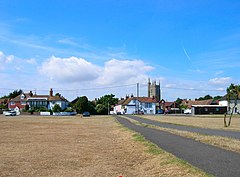Lydd
| Lydd | |
|---|---|
 The Rype, Lydd |
|
| Lydd shown within Kent | |
| Population | 6,567 (2011) |
| District | |
| Shire county | |
| Region | |
| Country | England |
| Sovereign state | United Kingdom |
| Post town | Romney Marsh |
| Postcode district | TN29 |
| Dialling code | 01797 |
| Police | Kent |
| Fire | Kent |
| Ambulance | South East Coast |
| EU Parliament | South East England |
| UK Parliament | |
Lydd is a town and electoral ward in Kent, England, lying on the Romney Marsh. It is one of the larger settlements on the marsh, and the most southerly village in Kent. Lydd reached the height of its prosperity during the 13th century, when it was a corporate member of the Cinque Ports, a "limb" of Romney. Actually located on Denge Marsh, Lydd was one of the first sandy islands to form as the bay evolved into what is now called the Romney Marsh. The name Hlyda, which derives from the Latin word for "shore", was found in a Saxon charter dating from the 8th century.
The parish of Lydd comprises the town of Lydd, Dungeness, Lydd-on-Sea and parts of Greatstone.
Notable buildings in Lydd include the Gordon house longhall, a guildhall and a mediaeval courthouse. Chamberlains and churchwardens accounts of the 15th century survive alongside the town charters.
Lydd developed as a settlement during the Romano-British period on a shingle island when the coast at the time cut off Lydd from the mainland. The settlement continued into the Saxon period, with the Saxon church using Roman materials as part of its early construction. The town reached the height of its prosperity during the 13th century, when it was a corporate member of the Cinque Ports, a "limb" of Romney. As with much of the marsh, the town was a base for smuggling in the 18th and 19th centuries.
Before the First World War Lydd became an important artillery practice camp. Experiments with high explosives carried out on the shingle wastes around 1888 led to the invention of the explosive Lyddite. Lydd was at one time a garrison town and the area is still an important training ground for the armed forces, at one time having an extensive narrow gauge railway network.
...
Wikipedia

